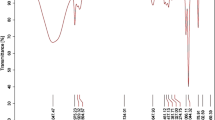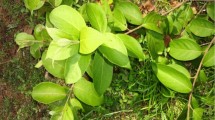Abstract
Sida cordata (Burm.f.) Borss.Waalk. is a perennial prostrate herb belonging to the family Malvaceae found in the tropical and subtropical plains of India, Sri Lanka and Pakistan. It is one of the most essential plants in Ayurveda and Siddha system of traditional medicine and is used to treat various diseases and ailments. The present study is carried out to investigate the preliminary phytochemicals and bioactive compounds of leaf extracts by GC–MS. GC–MS analysis of leaf extracts revealed the presence of 50 compounds in all four solvents. Petroleum ether extract showed the presence of 18 compounds, whereas ethanol extract showed 12 compounds; chloroform and acetone extracts showed the presence of 10 compounds each. Phytol is the most significant compound in petroleum ether (28.72%), ethanol (32.99%), and acetone (41.61%) extracts. Whereas in chloroform extract, 1,2-benzenedicarboxylic acid (49.07%) is the most significant bioactive compound having antioxidant, antifouling and antimicrobial properties.



Similar content being viewed by others
Data Availability
All the data obtained during this study are included in this article.
References
Che, C. T., George, V., Ijinu, T. P., Pushpangadan, P., & Andrae-Marobela, K. (2017). Traditional medicine. In Badal, S. McCreath, & R. Delgoda (Eds.), Pharmacognosy: Fundamentals, Applications and strategies (pp. 15–30). Academic.
Ramya, R. (2022). GC-MS analysis of bioactive compounds in ethanolic leaf extract of Hellenia speciosa (J.Koenig) S.R. Dutta. Applied Biochemistry and Biotechnology, 194, 176–186.
Dushyant, K. S., Parikshit, K. S., Rajesh, K. P., & Rajneesh, K. A. (2021). Ethnobotanical approaches, pharmacological and phytochemical benefits of genus Sida used in traditional medicines. Journal of Medical Pharmaceutical and Allied Sciences, 10(4), 3304–3309.
Khare, C., & P. (2007). Indian medicinal plants. An illustrated dictionary. Springer science, Springer-Verlag.
Dinda, B., Das, N., Dinda, S., Dinda, M., & Sharma, I. S. (2015). The genus Sida L. a traditional medicine: Its ethnopharmacological, phytochemical and pharmacological data for commercial exploitation in herbal drugs industry. Journal of Ethnopharmacology, 176, 135–176.
Gulnaz, A. R., & Savitha, G. (2013). Evaluation of antimicrobial activity of leaf and stem extracts of Siddha medicinal plant Sida cordata (Burm.f.) Borss.Waalk. International Journal of Medicine and Pharmaceutical Sciences, 3(3), 39–50.
Khatoon, S., Srivastava, M., Rawat, A. K. S., & Mehrotra, S. (2005). HPTLC method for chemical standardization of Sida species and estimation of the alkaloid ephedrine. Journal of Planar Chromatography, 18, 364–367.
Ganesh, M., & Mohankumar, M. (2017). Extraction and identification of bioactive components in Sida cordata (Burm.f.) Borss. Waalk. using gas chromatography-mass spectroscopy. Journal of Food Science and Technology, 54(10), 3082–3091.
Gnanasekaran, D., Umamaheswara, C. R., Jaiprakash, B., Narayanan, N., Elizabeth, H. S., & Kiran, R. Y. (2012). Adaptogenic activity of a Siddha medicinal plant: Sida cordata. International Journal of Pharmaceutical and Biomedical Research, 3(1), 7–11.
Shah, N. A., & Khan, M. R. (2014). Antidiabetic effect of Sida cordata in alloxan induced diabetic rats. BioMed Research International, 2014, 1–15.
Gulnaz, A. R., & Sneha, S. V. (2020). Effect of Sida cordata (Burm.f.) Borss. extracts on oral cancer: An in vitro study. International Journal of Current Microbiology and Applied Sciences, 9(5), 3052–3060.
Shinde, P. P., Khule, S. D., Sonawale, S., & Shelke, S. (2021). Anti-inflammatory activity of methanolic extract of plant Sida cordata in carrageen-induced paw edema in rats. Journal of Pharmaceutical and Scientific Innovation, 10(2), 53–55.
Kumar, D., Arora, S., Kumar, M., Takur, M. K., & Singh, A. P. (2014). Membrane stabilizing activity and antioxidant effect of Sida cordata (Burm.f.) Borss and Rhododendron arboretum SM. leaves. International Journal of Pharmaceutical Sciences and Research, 5(1), 165–170.
Banakar, P., & Jayaraj, M. (2017). Pharmacognosy, phytochemistry and GC-MS analysis of ethanolic stem extract of Waltheria indica L. - A potent medicinal plant. Journal of Biologically Active Products from Nature, 7(5), 369–378.
Nagannawar, A. G., & Jayaraj, M. (2018). Pharmacognosy and preliminary phytochemical investigation on Mollugo oppositifolia L., a traditional medicinal herb. Journal of Pharmacognosy and Phytochemistry, 7(4), 509–512.
Gulnaz, A. R., & Savitha, G. (2013). Phytochemical evaluation of leaf and stem extracts of siddha medicinal plant: Sida cordata (Burm.f.) Borss. Waalk. Journal of Evolution of Medical and Dental Sciences, 2(15), 2514–2521.
Singh, A. S., & Vellapandian, C. (2022). Phytochemical studies, antioxidant potential, and identification of bioactive compounds using GC–MS of the ethanolic extract of Luffa cylindrica (L.) Fruit. Applied Biochemistry and Biotechnology. https://doi.org/10.1007/s12010-022-03961-1
Sethuraman, S. P., & Ramachandran, K. P. (2022). Chemical profiling of volatile bioactives in Luisia tenuifolia Blume successive extracts by GC–MS analysis. Applied Biochemistry and Biotechnology, 194, 84–98.
Begum, F., Mohankumar, R., Jeevan, M., & Ramani, K. (2016). GC–MS analysis of bio-active molecules derived from Paracoccus pantotrophus FMR19 and the antimicrobial activity against bacterial pathogens and MDROs. Indian Journal of Microbiology, 56(4), 426–432.
Mujeeb, F., Bajpai, P., & Pathak, N. (2014). Phytochemical evaluation, antimicrobial activity and determination of bioactive components from leaves of Aegle marmelos. BioMed Research International, 2014, 1–11.
Swamy, N. T., Rosaiah, G., Babu, K., & Vijay, K. K. (2019). A study on phytochemical composition, GC-MS analysis and anti-microbial potential of methanolic leaf extract of Alstonia scholaris (L.) R. Br. International Journal of Pharmaceutical Sciences and Research, 10(3), 747–755.
Mishra, D. N., Gomare, K. S., & Sheelwant, S. V. (2020). GC-MS analysis and phytochemical screening of Indigofera tinctoria (Linn.) leaf extract characterizing its medicinal use. International Journal of Ayurvedic Medicine, 11(2), 289–299.
Arora, S., Kumar, G., & Meena, S. (2017). Screening and evaluation of bioactive components of Cenchrus ciliaris L. by GC-MS analysis. International Research Journal of Pharmacy, 8(6), 69–76.
Adnan, M., NazimUddin, C. M., Kamal, A. T. M., Azad, M. O. K., Paul, A., Uddin, S. B., Barlow, J. W., Faruque, M. O., Park, C. H., & Cho, D. H. (2019). Investigation of the biological activities and characterization of bioactive constituents of Ophiorrhiza rugosa var. prostrata (D.Don) & Mondal leaves through in vivo, in vitro, and in silico approaches. Molecules, 24(7), 1367.
Venkata Raman, B., Samuel, L. A., Saradhi, P. M., Rao, N. B., Vamsi Krishna, N. A., Sudhakar, M., & Radhakrishnan, T. M. (2012). Antibacterial, antioxidant activity and GC-MS analysis of Eupatorium odoratum. Asian Journal of Pharmaceutical and Clinical Research, 5(2), 99–106.
Koudehi, M. F., Ardalan, A. A., & Zibaseresht, R. (2020). Chemical constituents of an Iranian grown Capsicum annuum and their cytotoxic activities evaluation. Organic and Medical Chemistry International Journal, 9(3), 112–118.
Sudha, T., Chidambarampillai, S., & Mohan, V. R. (2013). GC-MS analysis of bioactive components of aerial parts of Fluggea leucopyrus Willd. (Euphorbiaceae). Journal of Applied Pharmaceutical Science, 3(05), 126–130.
Evran, S., Yaşa, İ, & Telefoncu, A. (2010). Modification of lysozyme with oleoyl chloride for broadening the antimicrobial specificity. Preparative Biochemistry & Biotechnology, 40, 316–325.
Krishnan, A., & Kandasamy, R. (2016). Phytochemical screening, GC-MS characterization and in vitro antibacterial activity of whole plant Blepharis boerhavifolia Pers. against MRSA. International Research Journal of Pharmacy, 7(12), 50–55.
Konovalova, O., Gergel, E., & Herhel, V. (2013). GC-MS analysis of bioactive components of Shepherdia argentea (Pursh.) Nutt. from Ukrainian flora. The Pharma Innovation – Journal, 2(6), 7–12.
Rautela, I., Parveen, A., Singh, P., & Sharma, M. D. (2019). GC-MS analyses of ethanolic leaf extract of medicinal plant Solanum nigrum. World Journal of Pharmaceutical Research, 8(7), 2299–2307.
Arora, S., Kumar, G., & Meena, S. (2017). Gas chromatography-mass spectroscopy analysis of root of an economically important plant, Cenchus ciliaris L. from Thar desert, Rajasthan (India). Asian Journal of Pharmaceutical and Clinical Research, 10(9), 64–69.
Jyothi, K. J., & Sunil, C. N. (2018). GC-MS analysis and nutrient evaluation of rare, endemic and threatened species- Aponogeton appendiculatus v. Bruggen of South India. Indian Journal of Scientific Research, 20(1), 07–11.
Soosairaj, S., & Dons, T. (2016). Bio-active compounds analysis and characterization in ethanolic plant extracts of Justicia tranquebariensis L. (Acanthaceae) – Using GC-MS. International Journal of ChemTech Research, 9(07), 260–265.
Zhao, F., Wang, P., Lucardi, R. D., Su, Z., & Li, S. (2020). Natural sources and bioactivities of 2,4-di-tert-butylphenol and its analogs. Toxins, 12(35), 1–26.
Adeyemi, M. A., Ekunseitan, D. A., Abiola, S. S., Dipeolu, M. A., Egbeyale, L. T., & Sogunle, O. M. (2017). Phytochemical analysis and GC-MS determination of Lagenaria breviflora R. fruit. International Journal of Pharmacognosy and Phytochemical Research, 9(7), 1045–1050.
Gideon, V. A. (2015). GC-MS analysis of phytochemical components of Pseudoglochidion anamalayanum Gamble: An endangered medicinal tree. Asian Journal of Plant Science and Research, 5(12), 36–41.
Mohan, S. C., & Anand, T. (2019). Comparative study of identification of bioactive compounds from Barringtonia acutangula leaves and bark extracts and its biological activity. Journal of Applied Sciences, 19(6), 528–536.
Yarazari, S. B., & Jayaraj, M. (2022). GC–MS analysis of bioactive compounds of flower extracts of Calycopteris floribunda Lam.: A multi potent medicinal plant. Applied Biochemistry and Biotechnology. https://doi.org/10.1007/s12010-022-03993-7
Acknowledgements
The authors acknowledge the Chairman, Department of Studies in Botany, Karnatak University, Dharwad, for providing the necessary facilities; KSTePS, Govt. of Karnataka, for financial support to one of the authors; and KFRI Trissur, Kerala, for GC-MS analysis.
Author information
Authors and Affiliations
Contributions
Mahantesh Banni: collection and processing of plant material, methodology, formal analysis and investigation, writing — original draft preparation. M Jayaraj: conceptualization, methodology, review, editing, and supervision.
Corresponding author
Ethics declarations
Ethical Approval
Not applicable.
Consent to Participate
Not applicable.
Consent for Publication
Not applicable.
Conflict of Interest
The authors declare no competing interests.
Additional information
Publisher's Note
Springer Nature remains neutral with regard to jurisdictional claims in published maps and institutional affiliations.
Rights and permissions
Springer Nature or its licensor holds exclusive rights to this article under a publishing agreement with the author(s) or other rightsholder(s); author self-archiving of the accepted manuscript version of this article is solely governed by the terms of such publishing agreement and applicable law.
About this article
Cite this article
Banni, M., Jayaraj, M. Identification of Bioactive Compounds of Leaf Extracts of Sida cordata (Burm.f.) Borss.Waalk. by GC/MS Analysis. Appl Biochem Biotechnol 195, 556–572 (2023). https://doi.org/10.1007/s12010-022-04115-z
Accepted:
Published:
Issue Date:
DOI: https://doi.org/10.1007/s12010-022-04115-z




